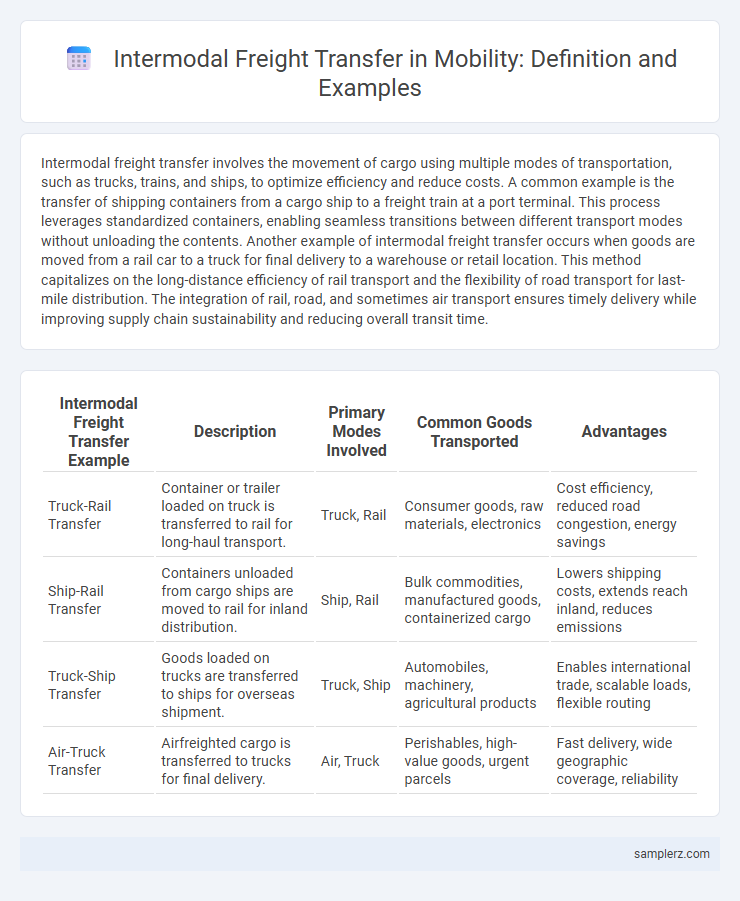Intermodal freight transfer involves the movement of cargo using multiple modes of transportation, such as trucks, trains, and ships, to optimize efficiency and reduce costs. A common example is the transfer of shipping containers from a cargo ship to a freight train at a port terminal. This process leverages standardized containers, enabling seamless transitions between different transport modes without unloading the contents. Another example of intermodal freight transfer occurs when goods are moved from a rail car to a truck for final delivery to a warehouse or retail location. This method capitalizes on the long-distance efficiency of rail transport and the flexibility of road transport for last-mile distribution. The integration of rail, road, and sometimes air transport ensures timely delivery while improving supply chain sustainability and reducing overall transit time.
Table of Comparison
| Intermodal Freight Transfer Example | Description | Primary Modes Involved | Common Goods Transported | Advantages |
|---|---|---|---|---|
| Truck-Rail Transfer | Container or trailer loaded on truck is transferred to rail for long-haul transport. | Truck, Rail | Consumer goods, raw materials, electronics | Cost efficiency, reduced road congestion, energy savings |
| Ship-Rail Transfer | Containers unloaded from cargo ships are moved to rail for inland distribution. | Ship, Rail | Bulk commodities, manufactured goods, containerized cargo | Lowers shipping costs, extends reach inland, reduces emissions |
| Truck-Ship Transfer | Goods loaded on trucks are transferred to ships for overseas shipment. | Truck, Ship | Automobiles, machinery, agricultural products | Enables international trade, scalable loads, flexible routing |
| Air-Truck Transfer | Airfreighted cargo is transferred to trucks for final delivery. | Air, Truck | Perishables, high-value goods, urgent parcels | Fast delivery, wide geographic coverage, reliability |
Overview of Intermodal Freight Transfer
Intermodal freight transfer integrates multiple modes of transportation such as rail, truck, and ship to optimize cargo movement across long distances. This process enhances efficiency by minimizing handling, reducing transit times, and lowering transportation costs. Key hubs for intermodal freight terminals feature advanced infrastructure including cranes, container yards, and railway sidings to facilitate seamless transfer between transport modes.
Key Components of Intermodal Freight Systems
Intermodal freight transfer relies on key components such as specialized containers, efficient terminals, and reliable drayage services to facilitate seamless cargo movement across multiple transportation modes. Containers standardized by the International Organization for Standardization (ISO) ensure compatibility between ships, trains, and trucks, optimizing loading and unloading processes. Terminal infrastructure equipped with advanced cranes and automated handling systems enhances transfer speed, while integrated tracking technologies provide real-time visibility throughout the supply chain.
Common Modes Combined in Freight Intermodal
Freight intermodal transportation integrates common modes such as rail, trucking, and maritime shipping to optimize efficiency and reduce costs. Rail is often used for long-haul bulk transport, trucking provides flexible last-mile delivery, and maritime shipping handles international container transfers. Combining these modes enhances supply chain reliability and lowers environmental impact through reduced fuel consumption.
Rail-to-Truck Intermodal Transfer Examples
Rail-to-truck intermodal transfer significantly enhances freight mobility by combining the long-haul efficiency of rail transport with the flexible last-mile delivery offered by trucks. Major freight hubs like the Port of Los Angeles and Chicago's intermodal terminals demonstrate efficient container transfer processes that reduce transit time and lower carbon emissions. Technologies such as automated crane systems and real-time tracking optimize cargo handling, improving overall supply chain reliability in rail-to-truck intermodal transfers.
Ship-to-Rail Intermodal Logistics
Ship-to-rail intermodal logistics efficiently combines maritime shipping and rail transport to streamline freight transfer, reducing transit times and lowering carbon emissions. Major ports like Los Angeles and Rotterdam utilize intermodal terminals where cargo containers seamlessly move from ships to trains for long-distance inland distribution. Leveraging rail networks enhances supply chain resilience and supports global trade with cost-effective, high-capacity freight solutions.
Air-to-Truck Freight Interchanges
Air-to-truck freight interchanges streamline cargo logistics by efficiently transferring goods from aircraft to trucking networks, minimizing handling times and reducing overall transit delays. Major airports such as Memphis International and Chicago O'Hare utilize specialized intermodal facilities designed for rapid truck loading and unloading, optimizing supply chain speed and reliability. This intermodal approach enhances freight connectivity and supports just-in-time delivery models critical for industries like e-commerce and automotive manufacturing.
Role of Containerization in Intermodal Freight
Containerization revolutionizes intermodal freight by enabling standardized containers to be seamlessly transferred between ships, trains, and trucks, minimizing handling and reducing transit times. The use of ISO-standard containers enhances cargo security and maximizes space utilization, significantly lowering logistical costs across global supply chains. Major ports and rail hubs equipped with specialized cranes and infrastructure further optimize container handling, ensuring efficient intermodal connectivity and faster delivery.
Major Intermodal Hubs and Facilities
Major intermodal hubs such as the Port of Los Angeles, Chicago's CenterPoint Intermodal Center, and the Port of Rotterdam serve as critical nodes in freight transfer, enabling seamless integration between rail, truck, and maritime transport. These facilities support high-capacity container handling, advanced logistics management, and real-time tracking systems that optimize cargo flow and reduce transit times. Efficient operation of such intermodal centers significantly enhances supply chain resilience and global trade connectivity.
Benefits of Intermodal Freight Transfer
Intermodal freight transfer combines rail, truck, and ship transport to optimize logistics efficiency and reduce transportation costs. It enhances supply chain reliability by leveraging each mode's strengths, such as rail's fuel efficiency and trucks' last-mile delivery capabilities. This integration lowers carbon emissions, supports sustainability goals, and improves freight handling flexibility across global networks.
Challenges in Multimodal Freight Integration
Multimodal freight integration faces significant challenges such as coordinating schedules across different transportation modes like rail, road, and sea, leading to delays and increased costs. Inadequate infrastructure and incompatible technology systems hinder seamless data exchange and real-time tracking, reducing operational efficiency. Regulatory differences and customs procedures across jurisdictions further complicate the transfer process, impacting the reliability of intermodal freight services.

example of intermodal in freight transfer Infographic
 samplerz.com
samplerz.com